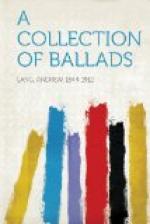THE DOUGLAS TRAGEDY
The ballad has Norse analogues, but is here localized on the Douglas Burn, a tributary of Yarrow on the left bank. The St. Mary’s Kirk would be that now ruinous, on St. Mary’s Loch, the chapel burned by the Lady of Branxholme when she
“gathered a band Of the best that would ride at her command,”
in the Lay of the Last Minstrel. The ancient keep of Blackhouse on Douglas Burn may have been the home of the heroine, if we are to localize.
THE BONNY HIND
Herd got this tragic ballad from a milkmaid, in 1771. Mr. Child quotes a verse parallel, preserved in Faroe, and in the Icelandic. There is a similar incident in the cycle of Kullervo, in the Finnish Kalevala. Scott says that similar tragedies are common in Scotch popular poetry; such cases are “Lizzie Wan,” and “The King’s Dochter, Lady Jean.” A sorrow nearly as bitter occurs in the French “Milk White Dove”: a brother kills his sister, metamorphosed into a white deer. “The Bridge of Death” (French) seems to hint at something of the same kind; or rather the Editor finds that he has arbitrarily read “The Bonny Hind” into “Le Pont des Morts,” in Puymaigre’s Chants Populaires du Pays Messin, p. 60. (Ballads and Lyrics of Old France, p. 63)
YOUNG BEICHAN, OR YOUNG BICHAM
This is the original of the Cockney Loving Ballad of Lord Bateman, illustrated by Cruikshank, and by Thackeray. There is a vast number of variants, evidence to the antiquity of the story. The earliest known trace is in the familiar legend of the Saracen lady, who sought and found her lover, Gilbert Becket, father of Thomas a Becket, in London (see preface to Life of Becket, or Beket), Percy Society, 1845. The date may be circ. 1300. The kind of story, the loving daughter of the cruel captor, is as old as Medea and Jason, and her search for her lover comes in such Marchen as “The Black Bull o’ Norraway.” No story is more widely diffused (see A Far Travelled Tale, in the Editor’s Custom and Myth). The appearance of the “True Love,” just at her lover’s wedding, is common in the Marchen of the world, and occurs in a Romaic ballad, as well as in many from Northern Europe. The “local colour”—the Moor or Saracen—is derived from Crusading times, perhaps. Motherwell found the ballad recited with intervals of prose narrative, as in Aucassin and Nicolette. The notes to Cruikshank’s Loving Ballad are, obviously, by Thackeray.




